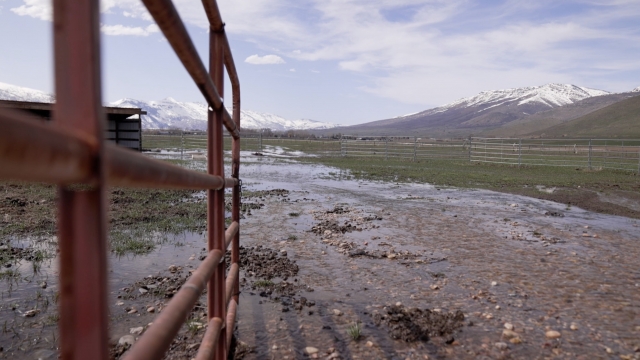For as far away as a place like a community sitting at 8,000 feet above sea level may feel, it's clear in the rushing rivers and flooded farmland of Northern Utah how far the reach is of melting snow on communities below, like where Lonny Bailey's family has farmed for six generations.
"This is a first, here," Bailey says as he looks at ducks swimming in the water that now covers his farmland in Huntsville, Utah — a small community roughly an hour north of Salt Lake City.
Bailey is bracing for the potential of more flooding on his farm. Usually, his water-soaked fields would have 6-inch-high alfalfa.
For nearly a month, the acres have been flooded. Warm temperatures in March melted snow in a nearby canyon, sending water onto his farm. For now, he can't grow hay or raise cattle.
"It's devastating to be a month and a half behind schedule," says Bailey.
Utah saw a historic amount of snow this winter. It broke its own record for its largest-ever snowpack.
Bailey says flooding combined with a longer winter that already put him behind means he won't have as much hay to sell this year.
"You talk to all the old timers up here, too — they've never witnessed this, especially with snowpack hanging on until the end of April, snow on the ground. This is very unusual for us," Bailey says.
Mountains in the West act like natural reservoirs, as the U.S. Department of Agriculture describes them. In the winter, they collect water in the form of snow and then release the water when temperatures rise in the spring.
SEE MORE: Up to 100 inches of water threaten northern California amid great melt
If too much snow melts too fast, it can create the potential for dangerous flooding.
"We're really concerned about how fast that snow melts and that runoff is going to happen with the temperatures," says Scott Paxman.
Paxman is the general manager and CEO of the Weber Basin Water Conservancy District, which oversees the water levels of multiple reservoirs and waterways north of Salt Lake City.
"Following the record-setting drought last year, it's greatly appreciated. But, we still have to make sure we are protecting life and property," Paxman says.
Paxman says since February, the district has released roughly three times the amount of water from their reservoirs and waterways compared to a typical year. It's in an effort to make room for the large amount of water that is expected to flow down from the mountains this spring.
For weeks, several communities have been handing out sandbags daily.
Doug Mortensen, who lives in a community alongside the Ogden River in Ogden, Utah, is relying on a wall that separates the river from his home.
"This is the highest that I've ever seen it," Mortensen says.
Beyond flooding, there is an increased concern that wet ground could trigger avalanches and mudslides. On Tuesday a 100-foot wide, 4-foot deep mudslide closed a road through Little Cottonwood Canyon south of Salt Lake City.
"It's just a guessing game. No one knows, but we have projections that help us predict," Paxman says.
Paxman expects the snowpack melt runoff to continue through mid-June.
Trending stories at Scrippsnews.com




